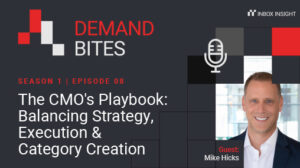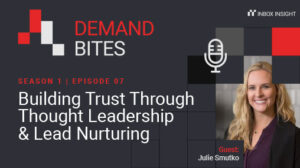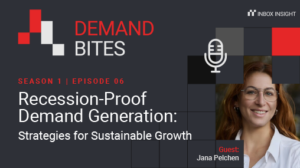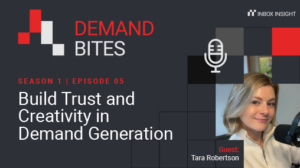Targeted Demand Generation may not be the first thing that comes to mind when you think of demand generation, yet this strategic approach combines the best of both demand generation and Account-Based Marketing (ABM) to drive customer interest and accelerate demand for products or services within B2B audiences.
Why is it a significant topic right now? Our customer research revealed that better quality Marketing-Qualified Leads (MQLs) and ABM were 2 of the key areas clients were focused on this year.
What is the appeal of Targeted Demand Gen for your B2B marketing strategy?
Read on for accessible advice around how both MQLs and ABM ambitions can be achieved through our model of Targeted Demand Generation…
Reading time: 5 minutes
The Targeted Demand Generation formula
Targeted Demand Generation serves as a precursor to ABM, not a fully-fledged ABM program. Essentially, it is where demand generation meets ABM (MQLs + account engagement) and bridges the gap.
By leveraging Targeted Demand Generation tactics, businesses can identify high-potential accounts and engage with them in a more personalized manner, while still maintaining the scalability of demand generation strategies. Together key components form the foundation of a powerful Targeted Demand Gen formula delivered at scale through strategic third party partnerships.
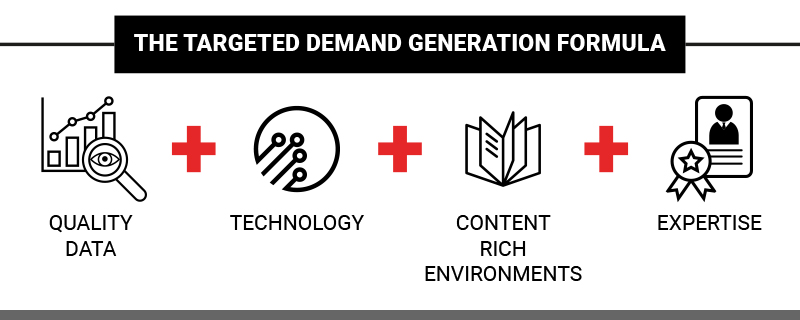
Warming up accounts is vital when it comes to ABM, as it enables sales teams to prioritize and pursue high-value accounts effectively. This is where Targeted Demand Generation comes in, as it is highly effective in creating MQLs while also uncovering valuable account intelligence. By combining these strategies, you can strengthen your ABM efforts and improve your chances of converting high-value accounts into loyal customers.
What is the appeal of Targeted Demand Generation?
Targeted Demand Generation operates by attracting and engaging key decision-makers within a select group of accounts that meet your Ideal Customer Profile (ICP). By delivering relevant and personalized content that addresses their current challenges and unique needs, you can start establish trust and credibility with your target accounts..
Contrary to traditional demand generation tactics, which focus on attracting the greatest volume of MQLs, Targeted Demand Generation takes a more strategic approach by diving deeper into the intelligence required to attain high-quality leads.
Short term wins:
In the short term it enables marketing teams to deliver a higher volume of high-quality marketing-qualified leads (MQLs) within a given timeframe. This in turn ensures that sales reps can focus their valuable time on sales calls and outreach on leads with the greatest potential to move through the demand generation funnel and convert into paying customers.
This ability to drive sales acceleration and pipeline uplift through high-quality leads from accounts most likely to purchase is backed heavily by data and analytics. Such analysis allows the tracking of engagement and response of the targeted accounts, enabling B2B marketers to refine and optimize their messaging and tactics accordingly for the best possible chance of attracting potential customers.
What’s more, while internal teams focus on building out an ABM architecture, marketing efforts can keep the MQLs flowing, ensuring that the sales pipeline remains active while sales teams continue to engage with prospects and close deals.
Longer term wins:
Targeted Demand Generation makes for a superior long-term engagement tactic through building lasting awareness and engagement amongst key accounts and customer account look-a-likes who show buyer intent against the key areas your business services. This means that B2B buyers will continue to keep you front of mind in the future – not only encouraging customer retention but aligning with your overarching business goals.
It is also a powerful strategy for providing crucial account intelligence to make better, more informed ABM strategic decisions. This approach enables businesses to hone in on the most promising opportunities and make more informed decisions around account prioritization and entitlements. By focusing on high-value accounts that match your Ideal Customer Profile (ICP), you can improve your chances of driving revenue growth and maximizing your return on investment (ROI).
Targeted Demand Generation also drives essential knowledge into your business that uncovers the unique needs and pain points of your ideal prospects. This allows you to understand:
- Exactly what your prospective customers are searching for
- The buying journey they will likely take
- The customer touchpoints they will interact with.
This enables marketing teams to focus their content marketing strategy accordingly, from early-stage engagement right through the marketing funnel.
How else can Targeted Demand Generation benefit B2B businesses?
Firstly, it has the ability to facilitate a jump in agility through leveraging third party large scale targeting capabilities – meaning that B2B businesses are not tied into lengthy contracts but can instead harness the benefits of strategic partnerships. The standard B2B demand generation strategy doesn’t allow this level of targeting, giving Targeted Demand Gen a distinct advantage.
It also allows digital marketing teams to build and deliver multichannel campaigns focused on specific account groups, to appeal to their specific pain points and areas of current interest via a range of advertising channels. This makes way for a fluid customer experience that results in business to business solutions being heard, understood and front of mind for potential customers.
One of the key benefits of Targeted Demand Generation is the ability to test new and even niche markets while minimizing risk. Rather than focusing solely on crowded markets, demand generation marketers can expand their horizons and explore untapped opportunities in new markets. It is the level of account detail that Targeted Demand Gen allows that gives marketers the confidence to test new markets with greater accuracy and effectiveness, enabling them to optimize their resources and plan more precise campaigns based on reliable data.
Finally, Targeted Demand Gen helps to engage more stakeholders within key accounts at a larger scale, without first party restrictions such as the CRM getting in the way. This is because it relies on third party targeting and marketing tactics that deliver rapid account intelligence, drilling into quality data that provides key insights into the most relevant content to deliver to engage quality potential leads.
Final thoughts
Standard B2B demand generation tactics seek to attract the highest volume of marketing-qualified leads (MQLs). Targeted Demand Generation aims to provide key decision makers in a select group of accounts with relevant, personalized and authoritative content that links directly with their unique challenges and needs. This is why ABM and demand generation marketing need to go hand in hand – forming third party strategic partnerships to engage members of target accounts and generate greater high-quality MQLs.
Data, analytics, and accompanying B2B marketing tools play a key part in this, to track the engagement and response of target accounts so that B2B marketers can enhance their marketing methods and messaging accordingly.
Remember It’s quality data, technology, content rich environments and expertise that make up the Targeted Demand Generation formula, to create MQLs that feed sales pipelines and achieve ABM objectives through account engagement – effectively generating a greater return on investment than your existing demand generation efforts can allow.


